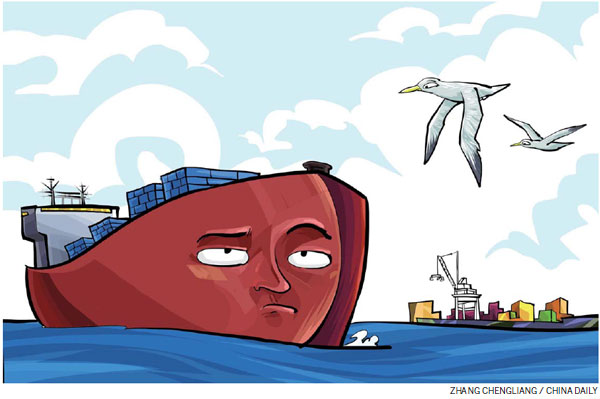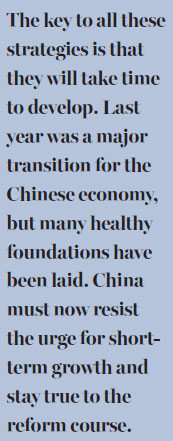Reforms will raise the quality of trade
Updated: 2016-01-08 07:54
By Oliver Barron(China Daily Europe)
|
|||||||||||

Ministry of Commerce's growth target for 2015 unlikely to be met, marking the fourth year of disappointment in a row
China is set for 2015 to be its worst annual performance in trade since the global financial crisis 2009. Instead of trying to drive a recovery in 2016, policymakers would be better off focusing on structural reform, which could generate higher quality trade for years to come.
China's trade fell by over 8 percent year-on-year in the first 11 months of the year in US dollar terms. As the Ministry of Commerce set a target to see trade expand by 6 percent for 2015, it will be the fourth consecutive year that China misses its target.
A portion of the weakness can be attributed to the decline in global commodity prices. As China is a major importer of commodities such as iron ore, copper and crude oil, the fall in commodity prices has played a role in the 14.9 percent decline in imports in the first 11 months of the year. Before commodity prices collapsed, major commodities accounted for roughly a quarter of overall imports in value terms.
The decline in imports goes beyond commodities, however. Excluding the major commodities of iron ore, copper, coal, crude oil and steel, Chinese imports were still down 8.5 percent in the first 11 months, a reflection of the economic slowdown and broader structural adjustment away from the industrial sector, which fell into contraction in the third quarter of 2015. While an emerging consumer class can drive imports higher in years to come, its rise will simply not be enough to offset the weakness in the industrial sector in 2016.

More of concern than China's import growth is the 2.6 percent decline in China's exports for January-November, including a nearly 7 percent fall in exports in November alone. Exports would have to grow by around 25 percent in December for China to avoid seeing exports decline on an annual basis for the first time since 2009.
The global economy is not helping China, either. In September, World Trade Organization economists lowered their target for 2015 trade growth to 2.8 percent, from a 3.3 percent forecast made in April, and reduced their estimate for 2016 to 3.9 percent from 4 percent. They warned that the target could be subject to further downgrades. For the fourth year in a row, WTO economists expect that the volume of global trade will grow more slowly than global growth as demand recovers slowly.
The Organization for Economic Cooperation and Development is even less optimistic, expecting trade to grow at just 2 percent in 2015. Its chief economist, Catherine Mann, referred to the weak global trade as "deeply concerning", highlighting that such growth rates have historically been associated with global recessions.
Against this backdrop, it is not difficult to see why China's exports have been weak. But there are other factors that have contributed to China's poor trade outlook. In particular, China is becoming less and less competitive as wages rise and the Chinese currency, the yuan, remains strong.
Data from the Bank of International Settlements indicate that the yuan has appreciated by 15 percent since June 2014 in trade-weighted terms, the largest increase by any major currency over the period. By contrast, China's Asian competitors have seen stable or depreciating currencies, including a 1 percent depreciation for South Korea, 9 percent depreciation for Japan and 14 percent depreciation for Malaysia.

It is this large appreciation of the yuan on a trade-weighted basis that has led the Chinese central bank to apparently begin targeting a basket of currencies with its exchange rate policy, rather than simply the US dollar. The China Foreign Exchange Trading System in December released a yuan exchange rate composite index against a basket of currencies, which may be the gauge the central bank uses for policy setting in the future. If the US dollar remains strong, we could expect to see the yuan continue its depreciation against the dollar, adding to the already more than 4 percent drop since August.
Meanwhile, wages have increased by an average of nearly 12 percent per year over the last five years. The combination of the two explains why China's competitiveness has been eroded in the low-end manufacturing space that it has been known for, and why export growth has been slowing for a number of years. Before last year's fall, exports expanded 6 percent in 2014, after rising 7.8 percent in 2013, 7.9 percent in 2012, 20.3 percent in 2011 and 31.3 percent in 2010.
Realizing this trend, policymakers have sought to find new ways of boosting exports, including developing new markets for Chinese goods, as well as changing what it exports.
The key to China's trade strategy for finding fresh markets is new initiatives like the Belt and Road Initiative and new institutions like the Asian Infrastructure Investment Bank, Silk Road Fund and New Development Bank. Overall, China announced more than $200 billion of funding last year for new and existing financial institutions to support the Belt and Road scheme.
In general, China hopes to use the Belt and Road Initiative to increase investment in neighboring countries, and then feed off of those countries' growth by exporting more goods and services to them. Trade with ASEAN nations has grown faster than total trade in each of the last four years and its share of total trade rose from 8.8 percent in 2010 to 12.3 percent of the total in the first 11 months of 2015. China wants this trend to continue.
Policymakers also want to adjust the structure of exports, moving away from low-end goods to more value-added products. Last year, the government released its Made in China 2025 Plan, aimed at moving the country up the manufacturing value chain. It will see China build core competencies in new industries such as IT, telecommunications, robotics, railway equipment, new energy vehicles, power equipment and medical devices, which it can then export. China has already had some success exporting railway and telecommunications equipment, and others should follow.
Simultaneously, China continues its campaign for international recognition of its currency. It is rolling out more currency swaps, has increased convertibility in the Shanghai Free Trade Zone and launched a new cross-border global payment system that will increase the attractiveness of using the yuan by reducing transaction costs and processing times. Furthermore, the yuan will be included in the IMF's Special Drawing Right in October, theoretically boosting demand for the currency.
Globally, the yuan is the second most used currency in trade financing and fifth most used currency in global payments, after the US dollar, the euro, sterling and the yen. While the recent depreciation of the yuan has reduced demand in the short term, China's plans to expand ties with Asian neighbors in terms of trade, infrastructure and financial markets will lead to an expanded role for the currency.
The key to all these strategies is that they will take time to develop. Last year was a major transition for the Chinese economy, but many healthy foundations have been laid. China must now resist the urge for short-term growth and stay true to the reform course.
The author is head of the China office of London-based China economics research company NSBO. The views do not necessarily reflect those of China Daily.
Today's Top News
Going mobile
Wealth of options for China's super-rich
Man with knife shot dead outside Paris police station
Trading halted after shares fall 7% in opening minutes
China voices its 'resolute opposition' to DPRK test
Design exhibition to attract Chinese art works
Germans shaken by mass attacks on women
Concerns grow over Saudi-Iranian rising tensions
Hot Topics
Lunar probe , China growth forecasts, Emission rules get tougher, China seen through 'colored lens', International board,
Editor's Picks

|

|

|

|

|

|






